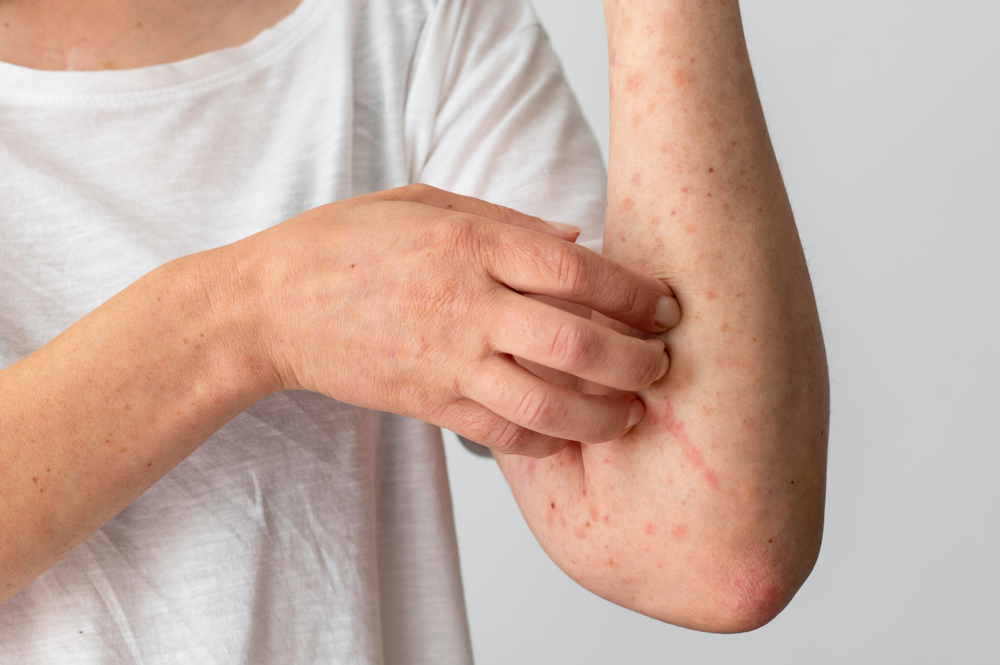- Fast results
- 4,000+ locations
- 4.8 star rating
Need Help? (888) GET LABS



Latex allergy is not unheard of. But people often learn more about it when they have already developed the condition. Using latex products or being continuously exposed to rubber for a long time can lead to latex allergy. As a result, you may find yourself experiencing allergic reactions to latex despite not having symptoms. Find out how this condition pans out and what products to avoid.
A latex allergy is when you develop a sensitivity to latex products or rubber characterized by symptoms of an allergic reaction. For example, you may experience hives, itching, a runny nose, and even fever-like symptoms. These will depend on your degree of sensitivity to the material.
An allergic reaction may occur when you’re exposed to latex through skin contact, blood transfer, inhalation of latex substance, or close contamination in your mucous membranes. A latex allergic reaction can manifest in the form of contact dermatitis or as a nasal allergy.
Contact dermatitis caused by latex can lead to skin problems spreading throughout your body. It may happen a few hours after exposure or even days. On the other hand, a nasal allergy due to latex additives produces hay fever-like symptoms. It’s regarded as more severe than contact dermatitis since it directly affects breathing.
Learn more about what latex allergy is and if you’re at risk of developing the condition.
You may suddenly become sensitive to latex, especially if you have frequent exposure to latex products. Aggregate latex exposure accounts for the highest case of how such allergies emerge.
Hence, it’s possible that you may tolerate it, but over a certain period of time, you become highly allergic. While other factors may come into play, exposure remains a critical point in activating the triggers.
Anyone can develop a latex allergy. However, some people have higher chances of doing so than others. This is mainly due to exposure and how their immune system reacts to the allergen. Among them are the following people.
Healthcare workers require wearing latex gloves to prevent microbial contamination and ensure that they perform procedures with sterility.
Outside the medical and dental field, those working in beauty services, chemical handling, janitorial services, and the like also need gloves.
This constant exposure increases the risk of latex glove allergy, especially as the immune system eventually tags the latex protein as a harmful foreign substance.
Did You Know? Aside from latex allergy, healthcare workers also need to carefully follow medical protocols to diminish exposure to various sorts of disease-causing microbes. Check out the most common infections healthcare workers are at risk of in their workplace.
Individuals involved in the production of rubber-based products can also develop latex allergies. In fact, as they have more exposure to raw rubber, they have a higher rate of inhaling latex particles that trigger rhinitis and respiratory symptoms.
Aside from the cumulative latex exposure through the gloves worn by surgeons and nurses, those who have to go through multiple surgeries also extend their exposure to moist internal issues, which triggers an immune response.
According to a study involving children with spina bifida, a higher incidence of latex sensitivity was noted, with a margin of 20.4% compared to the control group. As a result, guidelines on latex allergy preventive measures were set for children diagnosed with the condition. These include completely avoiding skin contact with and inhaling any rubber product and its particles.
If you already have allergies to food like avocado, banana, chestnut, kiwi, tomato, melons, papaya, potato, apple, celery, and carrot, you’ll have a higher affinity to suddenly develop a latex food allergy. This is because these foods contain similar latex proteins, which triggers the allergic reaction.
The cross-reactivity goes both ways, meaning you can have these food allergies if you have been diagnosed with latex hypersensitivity.

The first set of latex allergy symptoms you may notice are hives, rash, and itchiness if the exposure triggers irritant skin dermatitis. On the other hand, you may not have touched latex but got exposed to latex particles, which could lead to sneezing, runny nose, scratchy throat, wheezing, and watery eyes.
These symptoms can come mildly or severely depending on how long and how much latex you’ve come in contact with.
Nevertheless, if this is the first time you have experienced an allergic reaction, your next step should visit your healthcare provider for a proper diagnosis. Testing allergies can be done through a skin test or blood test.
Which one you should take depends on multiple factors. For example, your doctor may recommend taking a latex allergy test via blood sampling if you have other skin conditions exhibiting the same symptoms as an allergic reaction. Ask your physician about the most suitable option for your case.
Much like other allergies, you can treat latex allergy through antihistamines, hydrocortisone cream, and corticosteroid medications. That is if the symptoms are limited to skin irritation. Severe allergic reactions may need professional medical intervention to control the symptoms.
Once it’s confirmed that you do have hypersensitivity to latex, the best thing to do is avoid any latex or rubber product. This requires consciousness as tons of home goods and common items can be made of latex. For better guidance, be familiar with these materials, which include the following:
In addition, dental and medical products used in hospitals contain rubber or latex, such as IV tubing and EKG pads.
Given its ubiquity, make sure to inform people, like those providing services in salons, restaurants, etc., about your latex allergy, especially if you show severe allergic reactions to the material. Plus, consider organic alternatives to everyday household items. For example, go for the bamboo-made option instead of a rubberized toothbrush.
Without immediate medical intervention, latex allergy can lead to anaphylaxis, a severe form of allergic reaction that impedes breathing and can eventually lead to respiratory collapse. Anaphylactic shock constricts your airways and leads to a significant drop in your blood pressure which can become life-threatening. With its fatal effect on hand, it’s best to take latex allergic reactions seriously, treating it as a medical emergency as soon as symptoms show no signs of stopping.
Allergic reactions to latex can last for about 30 minutes to an hour. It can sometimes extend longer depending on your exposure to latex. If you’re experiencing new or more aggressive symptoms, especially shortness of breath, seek medical help immediately, regardless if you’re already aware of your allergic reactions to latex.
There is still no cure for allergies triggered by latex. It’s unlikely that the condition will get rid of itself. Instead, you’ll have to rely on over-the-counter (OTC) medication and other prescribed treatments to alleviate the symptoms. In addition, avoid having direct contact with latex, either by touch or inhalation.
Allergies develop at a certain age and through specific triggers. The same notion remains true with latex. Repeated exposure and a preexisting allergy to other types of allergens can lead to the sudden development of the condition. That said, it only makes sense to be extra cautious about latex allergy symptoms, especially if you are at a higher risk of having one. See your doctor to undergo proper testing and diagnosis.
Related Articles:

© Copyright 2025 Personalabs. All Rights Reserved.